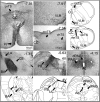Activation of the Medial Prefrontal Cortex Reverses Cognitive and Respiratory Symptoms in a Mouse Model of Rett Syndrome
- PMID: 29333487
- PMCID: PMC5762598
- DOI: 10.1523/ENEURO.0277-17.2017
Activation of the Medial Prefrontal Cortex Reverses Cognitive and Respiratory Symptoms in a Mouse Model of Rett Syndrome
Abstract
Rett syndrome (RTT) is a severe neurodevelopmental disorder caused by loss-of-function mutations in the gene encoding methyl-CpG-binding protein 2 (MeCP2; Amir et al., 1999), a transcriptional regulatory protein (Klose et al., 2005). Mouse models of RTT (Mecp2 mutants) exhibit excitatory hypoconnectivity in the medial prefrontal cortex (mPFC; Sceniak et al., 2015), a region critical for functions that are abnormal in RTT patients, ranging from learning and memory to regulation of visceral homeostasis (Riga et al., 2014). The present study was designed to test the hypothesis that increasing the activity of mPFC pyramidal neurons in heterozygous female Mecp2 mutants (Hets) would ameliorate RTT-like symptoms, including deficits in respiratory control and long-term retrieval of auditory conditioned fear. Selective activation of mPFC pyramidal neurons in adult animals was achieved by bilateral infection with an AAV8 vector expressing excitatory hm3D(Gq) DREADD (Designer Receptors Exclusively Activated by Designer Drugs) (Armbruster et al., 2007) under the control of the CamKIIa promoter. DREADD activation in Mecp2 Hets completely restored long-term retrieval of auditory conditioned fear, eliminated respiratory apneas, and reduced respiratory frequency variability to wild-type (Wt) levels. Reversal of respiratory symptoms following mPFC activation was associated with normalization of Fos protein levels, a marker of neuronal activity, in a subset of brainstem respiratory neurons. Thus, despite reduced levels of MeCP2 and severe neurological deficits, mPFC circuits in Het mice are sufficiently intact to generate normal behavioral output when pyramidal cell activity is increased. These findings highlight the contribution of mPFC hypofunction to the pathophysiology of RTT and raise the possibility that selective activation of cortical regions such as the mPFC could provide therapeutic benefit to RTT patients.
Keywords: DREADD; Mecp2; autism spectrum disorder; hypofrontality; mPFC; memory.
Figures








Similar articles
-
Cell-Genotype Specific Effects of Mecp2 Mutation on Spontaneous and Nicotinic Acetylcholine Receptor-Evoked Currents in Medial Prefrontal Cortical Pyramidal Neurons in Female Rett Model Mice.Neuroscience. 2019 Aug 21;414:141-153. doi: 10.1016/j.neuroscience.2019.07.008. Epub 2019 Jul 9. Neuroscience. 2019. PMID: 31299345
-
MeCP2 Deficiency Alters the Response Selectivity of Prefrontal Cortical Neurons to Different Social Stimuli.eNeuro. 2024 Sep 24;11(9):ENEURO.0003-24.2024. doi: 10.1523/ENEURO.0003-24.2024. Print 2024 Sep. eNeuro. 2024. PMID: 39266326 Free PMC article.
-
Mechanisms of Functional Hypoconnectivity in the Medial Prefrontal Cortex of Mecp2 Null Mice.Cereb Cortex. 2016 May;26(5):1938-1956. doi: 10.1093/cercor/bhv002. Epub 2015 Feb 7. Cereb Cortex. 2016. PMID: 25662825 Free PMC article.
-
Exploring the possible link between MeCP2 and oxidative stress in Rett syndrome.Free Radic Biol Med. 2015 Nov;88(Pt A):81-90. doi: 10.1016/j.freeradbiomed.2015.04.019. Epub 2015 May 8. Free Radic Biol Med. 2015. PMID: 25960047 Review.
-
Autonomic dysfunction with mutations in the gene that encodes methyl-CpG-binding protein 2: insights into Rett syndrome.Auton Neurosci. 2011 Apr 26;161(1-2):55-62. doi: 10.1016/j.autneu.2011.01.006. Epub 2011 Feb 12. Auton Neurosci. 2011. PMID: 21316312 Review.
Cited by
-
The antitussive cloperastine improves breathing abnormalities in a Rett Syndrome mouse model by blocking presynaptic GIRK channels and enhancing GABA release.Neuropharmacology. 2020 Oct 1;176:108214. doi: 10.1016/j.neuropharm.2020.108214. Epub 2020 Jul 3. Neuropharmacology. 2020. PMID: 32622786 Free PMC article.
-
Development of prefrontal cortex.Neuropsychopharmacology. 2022 Jan;47(1):41-57. doi: 10.1038/s41386-021-01137-9. Epub 2021 Oct 13. Neuropsychopharmacology. 2022. PMID: 34645980 Free PMC article. Review.
-
Potentiation of the M1 muscarinic acetylcholine receptor normalizes neuronal activation patterns and improves apnea severity in Mecp2+/- mice.Neurobiol Dis. 2025 May;208:106859. doi: 10.1016/j.nbd.2025.106859. Epub 2025 Feb 26. Neurobiol Dis. 2025. PMID: 40021095 Free PMC article.
-
Excitation and Inhibition Imbalance in Rett Syndrome.Front Neurosci. 2022 Feb 18;16:825063. doi: 10.3389/fnins.2022.825063. eCollection 2022. Front Neurosci. 2022. PMID: 35250460 Free PMC article. Review.
-
Age- and sex-specific fear conditioning deficits in mice lacking Pcdh10, an Autism Associated Gene.Neurobiol Learn Mem. 2021 Feb;178:107364. doi: 10.1016/j.nlm.2020.107364. Epub 2020 Dec 16. Neurobiol Learn Mem. 2021. PMID: 33340671 Free PMC article.
References
-
- Alexander GM, Rogan SC, Abbas AI, Armbruster BN, Pei Y, Allen JA, Nonneman RJ, Hartmann J, Moy SS, Nicolelis MA, McNamara JO, Roth BL (2009) Remote control of neuronal activity in transgenic mice expressing evolved G protein-coupled receptors. Neuron 63:27–39. 10.1016/j.neuron.2009.06.014 - DOI - PMC - PubMed
-
- Alexandrov VG, Ivanova TG, Alexandrova NP (2007) Prefrontal control of respiration. J Physiol Pharmacol 58 [Suppl 5]:17–23. - PubMed
Publication types
MeSH terms
Substances
Grants and funding
LinkOut - more resources
Full Text Sources
Other Literature Sources
Medical
Molecular Biology Databases
